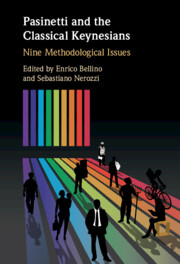Book contents
- Pasinetti and the Classical Keynesians
- Pasinetti and the Classical Keynesians
- Copyright page
- Contents
- Contributors
- Foreword
- Introduction
- 1 Reality (and Not Simply Abstract Rationality) as the Starting Point of Economic Theory
- 2 Economic Logic with Internal Consistency (and Not Only Formal Rigour)
- 3 Malthus and the Classics (Not Walras and the Marginalists) as the Major Inspiring Source in the History of Economic Thought
- 4 Non-ergodic (in Place of Stationary, Timeless) Economic Systems
- 5 Causality vs. Interdependence
- 6 Macroeconomics before Microeconomics
- 7 Disequilibrium and Instability (Not Equilibrium) as the Normal State of the Industrial Economies
- 8 Necessity of Finding an Appropriate Analytical Framework for Dealing with Technical Change and Economic Growth
- 9 A Strong, Deeply Felt, Social Concern
- 10 Why the Classic-Keynesian Trend May Be of Interest to a Young Scholar Today
- 11 Pasinetti’s Separation Theorem
- Author Index
- References
Introduction
Published online by Cambridge University Press: 17 February 2022
- Pasinetti and the Classical Keynesians
- Pasinetti and the Classical Keynesians
- Copyright page
- Contents
- Contributors
- Foreword
- Introduction
- 1 Reality (and Not Simply Abstract Rationality) as the Starting Point of Economic Theory
- 2 Economic Logic with Internal Consistency (and Not Only Formal Rigour)
- 3 Malthus and the Classics (Not Walras and the Marginalists) as the Major Inspiring Source in the History of Economic Thought
- 4 Non-ergodic (in Place of Stationary, Timeless) Economic Systems
- 5 Causality vs. Interdependence
- 6 Macroeconomics before Microeconomics
- 7 Disequilibrium and Instability (Not Equilibrium) as the Normal State of the Industrial Economies
- 8 Necessity of Finding an Appropriate Analytical Framework for Dealing with Technical Change and Economic Growth
- 9 A Strong, Deeply Felt, Social Concern
- 10 Why the Classic-Keynesian Trend May Be of Interest to a Young Scholar Today
- 11 Pasinetti’s Separation Theorem
- Author Index
- References
Summary
In 2005, Luigi Pasinetti was asked by his friend and colleague Pier Paolo Varri how he would like his seventy-fifth birthday to be celebrated. Pasinetti immediately replied: ‘let us discuss my new book!’. The book was, of course, Keynes and the Cambridge Keynesians, which was almost finished at that time. One of the most original and provocative parts was the ‘Postlude: Fighting for Independence’ of Book Two (The Cambridge School of Keynesian Economics), where he portrays what he considers the main features of the classical-Keynesian school, offering a list of nine theoretical and methodological characteristics, qualifying and unifying (to some extent, at least) the economists associated with it (Pasinetti, 2007, pp. 217–237). When, about a couple of years ago, John E. Woods (a student of Luigi Pasinetti at King’s College in the late 1960s) and Philip Good (economics editor of Cambridge University Press) launched the idea of a collection of essays discussing Pasinetti’s ‘nine characteristics’, we felt it certainly an appropriate, though a somewhat unconventional, way to celebrate Pasinetti’s career as an economist.
- Type
- Chapter
- Information
- Pasinetti and the Classical KeynesiansNine Methodological Issues, pp. 1 - 12Publisher: Cambridge University PressPrint publication year: 2022

